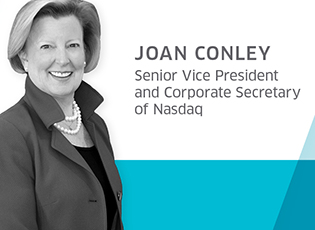
The Art of Recording Board Meeting Minutes

The importance of accurate and thorough minutes of board meetings to good corporate governance cannot be understated. Meeting minutes serve as an impartial “witness” that a board is meeting its fiduciary obligations and employing a deliberative decision-making process.
In this post designed to help Chief Governance Officers build a better governance framework, Joan Conley, Nasdaq Senior Vice President and Corporate Secretary, shares best practices for taking great notes at board meetings and explains how you can leverage technology to draft, distribute, and approve meeting minutes.
There is an art to taking board minutes, and this highly confidential task requires strong critical thinking skills and professional judgement to enable a minute taker to accomplish the following:
- Discern materiality and appropriate level of detail when recording the board’s deliberation of decisions and actions;
- Distinguish between discussions about actions that trigger SEC Form 8-K reporting and approvals of those actions; and
- Understand what constitutes “privileged discussions” with legal counsel during board meetings.
There are numerous checklists available online from governance professional associations and law firms that detail “what” information to include in meeting minutes. The art of recording high quality meeting minutes, however, lies in the “how,” as outlined below.
1. Prepare ahead of time to ensure high quality content.
The secret to taking great notes at board meetings is advance preparation, on several fronts.
Study before the meeting. Intimate knowledge of the meeting agenda, board books, supportive material and key documents allows the note taker to follow the conversation and anticipate the discussion points, actions and motions that should be recorded. Minutes from the previous meeting should also be reviewed in advance.
Create a “meeting minutes template” and take meeting notes on it. A robust template frees the secretary from transcribing standard information (such as attendance lists, type of meeting, location and time) and allows him or her to focus instead on capturing decisions, motions, and key deliberations. If your company has recently issued stock to the public, ask corporate counsel to assist in developing a template for meeting minutes that meets applicable standards.
An extended agenda (as outlined in the previous paper of this series) serves as an excellent baseline template for meeting minutes. Language for proposed motions and board actions can be added ahead of time, as can references to board documents and materials. Leave large blank areas between template sections for notes.
Sit close to the board chair. Often times the corporate secretary is simultaneously taking minutes and running the board presentation for the board chair and CEO. The corporate secretary should sit next to, or very near, the board chair. This allows the note taker to discreetly ask for clarifications without disrupting the flow of the meeting.
2. Keep track of action items with a matrix.
Board meeting minutes are meant to record motions, decisions and actions taken by the board. The “belts and suspenders” details of administrative board work, such as follow-up items, assigned action items and director to-do lists are not appropriate to include in board meeting minutes. However, they do need to be tracked somewhere.
At Nasdaq, we maintain spreadsheets to record and track any routine action items that are part of the charter of the board and its committees, as well as follow up items identified during meeting discussions. The spreadsheets describe each task and identify the category it falls in, who is responsible and when it will be taken for discussion. This ensures action items are carried over from one meeting to the next.
3. Leverage your board portal software to draft, distribute and approve minutes.
Converting detailed meeting minutes to summation form is a laborious task, whether the minute taker is typing or handwriting notes. And, time is of the essence—it’s best practice to distribute draft meeting minutes to the board for review promptly, while memories are fresh.
The board portal is an indispensable tool for streamlining the process of drafting, distributing, and approving minutes. With meeting agendas, attendance lists, action item matrices and board documents centrally located within in the board portal, drafting meeting minutes is considerably more convenient. Utilizing the portal to distribute drafts and coordinate the review and approval of the final record of board minutes brings convenience and speed to the process for directors as well.
4. Adhere to a consistent process.
Board meeting minutes are essential to demonstrating accountability and disclosure to shareholders, company employees, the investing public and regulators. It’s important that a company and its directors follow a consistent timeline and process for recording and approving board minutes. Should minutes fall under the scrutiny of litigation, a consistent approach is tangible evidence of a corporate board’s intent to be accountable and transparent.
5. Solicit a board meeting minutes “report card” annually.
Board meeting minutes can be used to defend the board in legal proceedings or form a part of audit or regulatory reviews, so it’s good protocol to have experts review them for quality and accuracy. I routinely forward Nasdaq’s board meeting minutes to corporate counsel, our staff liaison, and/or internal auditor. I ask my team of experts to examine our board meeting minutes through the prism of litigation to identify how information can be clarified or improved upon.
For more insights from Joan Conley, read:
Seven Tactics to Engineer Better Boardroom Dynamics >>
Onboarding New Directors: Beyond the Board Manual >>
Joan Conley is Senior Vice President and Corporate Secretary of Nasdaq and its global subsidiary organizations and, in that role, is responsible for the Nasdaq Corporate Governance Program and Nasdaq Ethics Program. She also serves as Managing Director of the Nasdaq Educational Foundation and is a Director of the Nasdaq Entrepreneurial Center Board.
The views and opinions expressed herein are the views and opinions of the author and do not necessarily reflect those of Nasdaq, Inc.
